Alone in the Universe
By Howard A. Smith
Despite the growing catalog of extrasolar planets, data so far do not alter estimates that we are effectively on our own
Despite the growing catalog of extrasolar planets, data so far do not alter estimates that we are effectively on our own

DOI: 10.1511/2011.91.320
The first known extrasolar planet (that is, a planet orbiting around a normal star other than our Sun) was 51 Pegasi b, discovered only about 16 years ago. Today, thanks largely to NASA’s orbiting Kepler satellite, there are more than 1,500 known extrasolar planets (or planetary candidates), about 431 with confirmed detections and reasonably well- determined parameters (such as radius, mass and orbital characteristics).
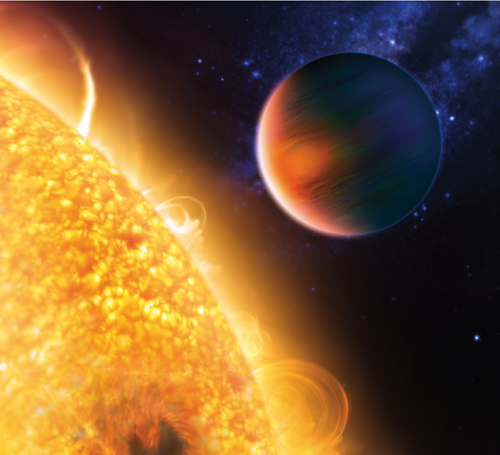
Image courtesy of ESA, NASA, G. Tinetti (University College London and ESA) and M. Kornmesser (ESA/Hubble).
These discoveries are exciting not only to astrophysicists; the public is also keen to learn about Earthlike extrasolar planets and the possibility that some might host life, even intelligent life. Last year the Royal Society of London sponsored a symposium with the dramatic title “The Detection of Extra-terrestrial Life and the Consequences for Science and Society.” Participants observed, “Should it turn out that we are not alone in the universe, it will fundamentally affect how humanity understands itself,” and cited polls suggesting that most people believe we do have cosmic company (half of this group think aliens have already visited). The public wants to believe in aliens (or extraterrestrial intelligence, ETI), some say, because they believe that “ETI comes from ‘utopian societies which are free of war, death, disease or any other … mid-20th century problems’ and could ‘help mankind overcome its problems.’”
Scientists and the press often encourage people to adopt these sensational attitudes. Last March, for example, the New York Times ran an op-ed piece on extrasolar planets by astronomer Ray Jayawardhana under an image of a sky full of stars labeled with “THEM” signposts. The author was reassuring: People should not fret about “life elsewhere, especially if it turns out to be in possession of incredible technology [that can] make us feel small and insignificant.” He did not speculate on the possibility that this science-fiction scenario might instead make people feel inconsequential or prompt them to treat each other, or our planet, casually.
The dawn of the era of extrasolar-planet (or exoplanet) discovery provides us with the first bits of hard information to use in reconsidering the likelihood of this popular attitude. The spin has been that because planets are common, alien civilizations must be abundant. But that doesn’t follow. The evidence so far does not alter the improbability that any ETI exists near enough to us to matter. It is therefore much more crucial for theology, philosophy, politics and popular opinion to ponder how humanity understands itself if we might be effectively alone in the universe—humanity being a species that is rare, precious and neither irrelevant nor cosmically insignificant.
Life—specifically intelligent life, not just microbes—could be ubiquitous in a universe that is as spacious and rich as ours; it is possibly teeming with Earthlike planets hosting life. Perhaps intelligent beings are the inevitable product of life and evolution. This view has been the traditional attitude, and one typical portrayer was Percival Lowell, an astronomer famous for his advocation of canals on Mars, who wrote in his 1908 book, Mars as the Abode of Life:
From all we have learned of its constitution on the one hand or of its distribution on the other we know life to be as inevitable a phase of planetary evolution as is quartz or feldspar or nitrogenous soil. Each and all of them are only manifestations of chemical affinity.
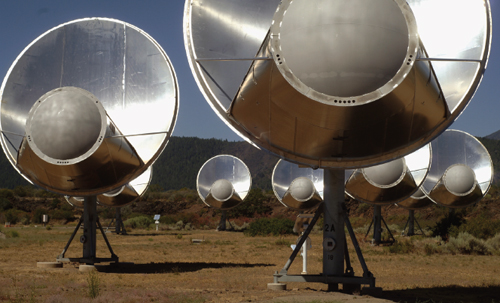
Image courtesy of the SETI Institute, photo by Seth Shostak.
Today we know that Mars has no artificial canals, and that this assertion was unsupported wishful thinking. Don Goldsmith and Tobias Owen, in their classic book, The Search for Life in the Universe (1993 edition), present a more modern view:
We anticipate that all planetary systems will have a set of rocky inner planets, with atmospheres produced by outgassing, weathering and escape, for the same reasons that our own rocky inner planets have atmospheres. Judging from our own example, the chances seem good that one of these inner planets will orbit its star at the “right” distance.… We say one in every two to be conservative.
Nowadays this view, too, appears narrow. The single most remarkable finding of the new research on extrasolar planets is that an enormous variety of systems exist—a diverse range of often-bizarre environments that is considerably broader than had usually been imagined before the first one was discovered. More than 50 likely Earth-sized planets have been spotted so far. Earthlike planets, with signs of liquid water and a congenial atmosphere, have as yet fallen below the detection threshold, although in the next few years, with the added patience it takes to measure a few of their yearly transits, it is reasonable to think that some will be found. It may turn out that our own solar system is average—but we know now that at least some planetary systems are unlike ours. Meanwhile, the results make it possible to improve models of planet formation, which in turn offer improved guidance on planets in general.
Two clarifications are essential. First, only the existence of intelligent beings is relevant. Primitive life may yet be discovered on Mars; perhaps even multicellular animals will be found on a nearby extrasolar planet. These revolutionary discoveries would help us reconstruct how life on Earth evolved, but unless a species is capable of conscious, independent thought and has the ability to communicate, we will still be alone—with no one to teach or learn from, no one to save us from ourselves (and no one to battle against). Intelligent life, for the purposes of this discussion, means life able to communicate between stars; this implies having something like radio technology. Our own society, by this definition, is only about 100 years old. If intelligent life is common in a universe that is 13.7 billion years old, then surely we are among the youngest forms in existence. As the physicist Enrico Fermi famously observed, however, the fact that there is no other known intelligent life indicates that the assumption is wrong—intelligent life is not common. Cosmologist Paul Davies explores this absence in detail in his 2010 book, The Eerie Silence: Renewing Our Search for Alien Intelligence.
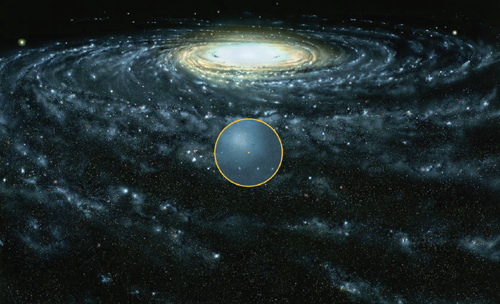
Jon Lomberg
The second important caveat derives from two features of the world that were unknown to Percival Lowell. The first is relativity—the fastest any signal can travel is the finite speed of light. The second is the expanding nature of the universe (presumably the result of a “big bang” creation event, although the origin of the expansion is not critical to the conclusions): Distant galaxies recede from us at an accelerating rate. Even if ETI is infinitesimally rare, in an infinite universe, every physically possible scenario, however bizarre, will exist. Stephen Hawking and other physicists argue for the existence of “many universes,” thereby inflating the notion of infinities and life forms. Such possibilities may be philosophically amusing, but they are practically irrelevant. We cannot communicate with, or even directly measure anything about, this unlimited vastness because it lies beyond the cosmic horizon, the distance set by how far light can travel in the age of the universe. Waiting longer will not help: The universe is getting bigger and expanding away from us. In fact, for purposes of communication the limit is even stricter. The universe is not simply expanding—it is accelerating outward, and Harvard astrophysicist Avi Loeb has shown that light sent from Earth today can never even catch up to galaxies whose light has taken about 10 billion years to reach us. Even though they are well within our cosmic horizon, such galaxies are forever beyond our reach and receding quickly. Even if the universe lasts forever, any aliens there will never enjoy our stray transmissions of I Love Lucy.
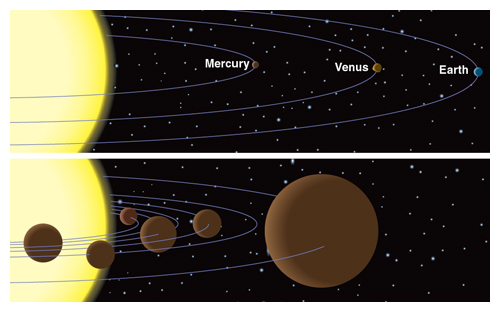
Illustration by Tom Dunne.
The finite speed of light also sets a practical limit on closer stars. Most stars in our Milky Way galaxy, and presumably its billions of planets, are hundreds of thousands of light-years away, so it will take hundreds of thousands of years for any ETI there to see our signals, and that long again for us to receive a reply. To be alone for all practical purposes means to be without any communication—or even the knowledge that any signal is coming—for a very long time. How long before we feel such solitude? My choice is 100 human generations; subjectively this seems like practically forever. Because one generation corresponds to 25 years (and at least one round-trip of messages is necessary), I limit the following estimates to stars closer to Earth than 1,250 light-years. We know a lot about the stars in this neighborhood and so we can be quantitative. If we choose to examine a smaller volume, say, that accessible within one lifetime, the chances of success go down by a factor of a million—because the number of stars is proportional to the volume of space and scales with time (distance) cubed—but we will have a yes-or-no answer sooner. However, if we expand the search volume and the probabilities of success, the wait time goes up.
Of course it is possible that some distant alien civilization scans the galaxy’s billions of stars for juvenile Earths, predicts their evolution and optimistically sends out greetings eons ahead of time—perhaps as signals or robotic probes—timed to arrive just when intelligent species (such as us) have evolved and are starting to listen. But it is hard to imagine such an enterprise being practical. No wonder there are no signals, nor even faint traces, despite decades of looking. As Fermi argued, they are not there. If perchance (in the spirit of Jayawardhana’s remarks) some fantastic, faster-than-light technology were possible, then Fermi’s observation implies that beings with ETI are not only not living in our galaxy, but there are not many living anywhere in the universe.
One way to figure the odds is to use the Drake Equation, a set of multiplicative factors tracking the various phenomena thought to be necessary to get to intelligent life. It is not a mathematical formulation of a physical process, and every researcher who uses it breaks down the individual terms somewhat differently, but all estimate the same thing—the number of civilizations around today. At its simplest, the result is a product of five terms: the number of suitable stars, the number of suitable planets around such a star, the probability of life developing on a suitable planet, the probability that life evolves to be intelligent and the typical lifetime of a civilization compared to the lifetime of its star.
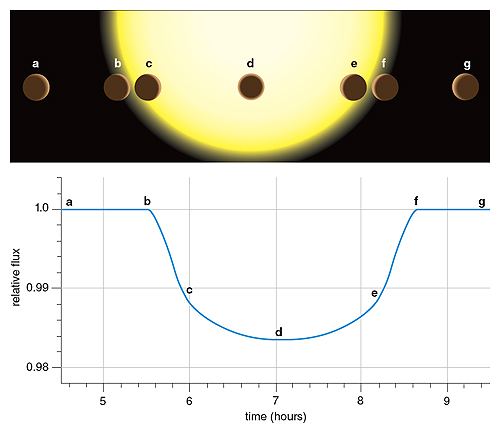
Illustration by Tom Dunne.
The individual factors, sub-factors and their values have been hotly debated since Frank Drake introduced the formula in the 1950s, because only the first variable could be reasonably estimated from physical evidence or extrapolated from a statistically meaningful sample, the number of solar-type stars (although the group of “suitable” stars might include more types).
The new results from extrasolar-planet searches impact the second term. As more extrasolar planetary discoveries are announced, I hope this discussion will help the public to evaluate whether they might be suitable sites for intelligent beings. The other factors remain rather mysterious and are extrapolations from an example of one—life on Earth. The usual attitude is that with about 1020 stars in the visible universe, even overestimating these factors by hundreds still leaves plenty of civilizations out there. But if we are unwilling to wait for a billion years to hear from ETI, and therefore only consider our stellar neighborhood, then small reductions matter a lot. It is impossible to increase the chances much over these early, optimistic estimates, but it is easy indeed to make the chances very much smaller.
The Sun lies in a cavity of interstellar gas, called the Local Bubble, which extends over roughly 600 light-years. It in turn is located in Gould’s Belt, a spur of stars, star clusters and molecular clouds between two of the Milky Way galaxy’s spiral arms, stretching from the Orion nebula to the Ophiucus-Scorpius clouds and on to the Perseus clusters—a distance of about 1,200 light-years in its longest dimension. The approximate number of stars per cubic light-year here is 0.004, to within a factor of two, or about 30 million stars of all types in a volume of radius 1,250 light-years. This result provides a first factor in the Drake Equation considering the distance limit that has been set, so the second term is the next to be considered.
The first thousand extrasolar planets discovered were the easiest to find in part because they are either large or have orbits close enough to their stars that their multiple transits in front of their stars can be observed, confirmed and studied in a few years. In their statistical review of 1,235 Kepler planetary candidates (planets not yet completely confirmed) that orbit in less than 50 days, University of California at Berkeley astrophysicist Andrew Howard and his team analyzed the trends they represent, including the finding that smaller planets are more abundant. There has not, however, been quite enough time to find Earthlike planets. Indeed, most of the stars studied have no planets of any kind yet detected, but in a few more years we may know more about them. The website for Exoplanet Data Explorer at http://exoplanets.org regularly updates the confirmed results. These first discoveries could represent unusual members of the family. Nonetheless, the new results have driven important refinements to models of planetary formation and evolution.
The “rare Earth” hypothesis expresses the idea that Earthlike planets genuinely suitable for intelligent life are few and far between. Paleontologist Peter Ward and astrophysicist Donald Brownlee of the University of Washington, among others, delineate a set of familiar conditions that planets must satisfy for intelligence to prosper, which I have bundled into four essential ones: stability, habitability and water, planetary mass and planetary composition.
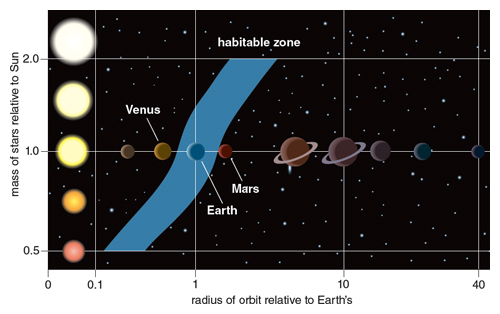
Illustration adapted by Tom Dunne from D. Brin, 1989, Earth.
To meet the stability condition, the host star must be stable in size and radiative output for the billions of years it takes for intelligence to evolve. Our Sun is among the less-common types of stars. Over 90 percent of stars are smaller than the Sun, many with less than one-tenth of the Sun’s mass. It may be hard for a planet around a small star to evolve intelligent life because small stars are cooler and their habitable zones—the range of distances where the temperatures allow water to be liquid—lie closer to the star. When a planet is in this closer region, it tends to become gravitationally (tidally) locked to the star, with one side perpetually facing the star. (Tidal locking keeps one face of the Moon pointing toward Earth.) But then half of the planet will be in the dark and cold, and the other half at constant noon. Life seems improbable in such a place, although some argue that life could develop in the zones with intermediate conditions.
At the other extreme, stars more massive than the Sun are also probably unsuitable; bigger stars burn hotter and live shorter lives. Stars with twice the mass of the Sun exist in a stable, hydrogen- burning, or “main sequence,” phase for only a few billion years, about 18 percent as long as the Sun’s lifetime—yet billions of years more than this were needed for evolution of intelligent life on Earth. Stars of more than about eight times the Sun’s mass will die as supernovae after only tens of millions of years. Fewer than about 10 percent of all stars are in a nominally acceptable range of masses, from about 0.7 to 1.7 solar masses.
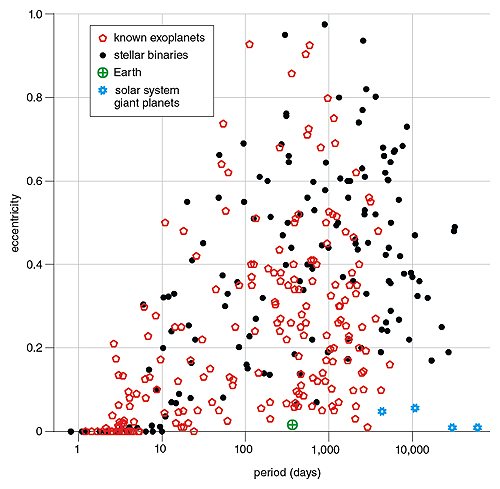
Figure courtesy of S. Udry and N. C. Santos, 2007, Annual Review of Astronomy and Astrophysics 45:397–439.
Moreover, a star’s age also matters. Stars that are too young will not have had time for life to evolve; older ones are problematic because a star’s luminosity increases with time (the Sun will be 40 percent more luminous in another 3.5 billion years), and thus the location of its habitable zone changes. Another concern is that most stars have a companion star orbiting; about two-thirds of solar-type stars are binaries. Their planets might orbit one star, or the other, or both, but these situations raise a flag because the changing gravitational influence of an orbiting companion star potentially could disrupt the long gestational period of a planet in a habitable zone.
The second condition for intelligent life, habitability and water, further explores the concept that a suitable planet must reside in the habitable zone of its star or have some other mechanism to maintain liquid water. The orbit must be stable as well, sufficiently circular or otherwise unchanging, so that it remains suitable for billions of years. The single most remarkable result from the discovery of extrasolar planets is their variety: systems that have extreme elliptical orbits, giant planets orbiting very close to their stars (called “hot Jupiters”) and other unexpected properties. It is important to stress again that technology is only just now able to detect Earth-sized planets. The presence of hot Jupiters in a system does not exclude the existence of Earthlike planets farther away in the star’s habitable zone, it just makes it more complicated. Planets are thought to form far from a star by the gradual coalescence of dust grains in a protoplanetary disk into larger and larger bodies. Once formed, these planets generally tend to migrate into closer orbits as they interact with material in the disk. As they migrate, such planets would presumably disrupt small bodies that might have been in the habitable zone, although one might remain there subsequently.
Another factor is the eccentricity of a planet’s orbit— a measure of the closest distance of the planet to the star compared to its largest distance—which thus determines the annual variations it receives in stellar illumination. Severe orbital variations do not preclude liquid water but could inhibit the development of biological systems. An eccentric orbit also increases the likelihood that in a system of similar planets, one occasionally might be chaotically disrupted. Earth’s orbit is nearly circular. Of the 431 extrasolar planets currently known with confirmed and published orbital parameters, only 11—2.2 percent—have eccentricity values less than that of Earth; 20 percent vary in their stellar distances by a factor of two during their year, and 50 percent vary in stellar distance by 20 percent.
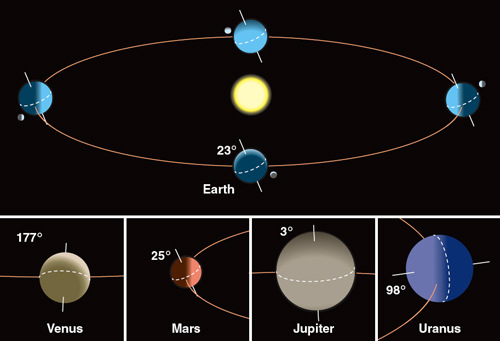
Illustration by Tom Dunne.
A related parameter is the obliquity of a planet, the angle between its spin axis and the axis of its orbit around its star. Earth’s obliquity, 23.5 degrees, is the consequence of a massive collision it had with a giant object early in its existence, which created the Moon. The approximate stability of Earth’s obliquity is maintained by torque from the Moon. This apparently ideal value of obliquity ensures that the climate on Earth’s surface over the course of a year is neither too hot nor too cold, as first one pole points slightly toward the Sun during Earth’s yearly orbit, and then the other receives more daylight. Scientists have estimated that if Earth’s obliquity were as high as 90 degrees, a substantial part of its surface would become uninhabitable. No other planet in our own solar system has such a stable, much less congenial, obliquity; that of Mars seems to have varied chaotically between about 0 and 60 degrees (but is currently about 25 degrees). Current models of Earth-sized planet formation suggest that high obliquity angles should be common, the result of collisions from all directions in early stages of formation, although the subsequent evolution of obliquities is less well understood. The rotation axes of stars can also be tilted with respect to the orbital plane. Measurements of exoplanets suggest so far that stars hosting hot Jupiters also have large obliquities, probably the result of strong gravitational perturbations in these extreme systems. Again, the current set of observed extrasolar planets represents the tip of the iceberg; most extrasolar planetary systems could be different. However, the explanations advanced so far to explain these observed parameters are general; whatever tends to produce highly elliptical orbits, for instance, is presumably at work, in some fashion, in other, still-unknown systems.
The third condition is planetary mass. A suitable planet must be massive enough to hold an atmosphere, but not so massive that plate tectonics are inhibited, because that would reduce geological processing and its crucial consequences for life. Current estimates are that planets smaller than about 0.4 Earth masses are unsuited for long-term atmospheres; if a planet is bigger than about 4 Earth masses, assuming it is rocky, then planetologists estimate it will be unable to produce the plate tectonics thought necessary to refresh the atmosphere with volcanoes or other processes associated with the carbon cycle. The frequency with which such planets occur is still not known, but the first indications from the Kepler satellite are that they are abundant: For planets in close orbits, about 13 percent are Earth-sized, and there is evidence that in larger orbits their numbers would be greater, especially in systems around smaller stars.
Then there is planetary composition. A suitable planet obviously must contain the elements needed for complex molecules (carbon, for example), but it also needs elements that are perhaps not necessary for making life itself but that are essential for an environment that can host intelligent life: silicon and iron, for example, to enable plate tectonics, and a magnetic field to shield the planet’s surface from lethal charged winds from its star. The core of Earth remains liquid because of the presence of radioactive elements, whose heat keeps the iron molten and energizes Earth’s internal temperature structure.
The relative abundance of the elements is not uniform throughout the galaxy, however, meaning that some regions may be incapable of hosting intelligent life. Furthermore, the need for radioactive elements means that a supernova, the primary source of radioactive elements, must have exploded in the vicinity of a suitable planet relatively recently (but not so close or so recently as to be dangerous). The Local Bubble in which the Sun resides is thought to have been caused by supernovae explosions, and so it might be the case that some key elements present in the Sun and Earth are deficient in other regions of our 1,250 light-year zone.
Finally, many planets may exist in open space, having been forcibly ejected from their stellar systems by multibody gravitational interactions. It is a stretch to imagine life on them developing and evolving to intelligence without the radiant energy of a stable star.
Even under ideal conditions life might not develop easily. The fact that life has not yet been created in the laboratory means that it is not trivially generated. Mars lies approximately in the habitable zone, but it hosts no civilizations. Even if life were the inevitable outcome of chemical processes on every planet with liquid water, there is no evidence that such fertility occurs quickly. On Earth life took about a billion years to form and another few billion years to produce us. If sometimes the chemistry runs slower by a factor of two or three, or evolution is sidetracked, it may be too late: A Sunlike star would have swollen in size to fill the orbit of Earth. Believers in ETI sometimes counter that some life might evolve from noncarbon-based forms much more efficiently. Besides the absence of any plausible evidence for such a possibility, most agree that at a minimum intelligence requires complexity. Even if their brains are not made with DNA, such aliens must evolve over timescales long enough for comparably complex organs to mature.

D. W. Miller
The development of intelligent life appears to require more than just planetary suitability. Consider the unlikely accidents—perhaps essential? perhaps incidental?—that facilitated humanity’s evolution. A gigantic collision early in Earth’s history created the Moon, knocking Earth’s axis over enough to make the obliquity and salutary seasons we enjoy, but not quite enough to shatter Earth entirely. Meanwhile the Moon that was produced generates Earth’s tides and stabilizes Earth’s wobble. A few billion years later, the dinosaurs, which had successfully dominated the planet for 100 million years, were fortuitously wiped out by another, smaller asteroid so powerful it destroyed them all, yet did not kill off the mammals. Many scientists have noted that there were roughly 15 mass extinctions, six of them catastrophic, on Earth before humans emerged on the scene, underscoring the complex, tumultuous, and perilous history of our evolution.
Many other contingent conditions on Earth enabled life to thrive. Water is essential, but if Earth had much more water in its oceans, there would be no landmass for fish to crawl onto and evolve into toolmakers. Moreover, the route that evolution took was circuitous. Evolutionary biologist Stephen J. Gould famously argued that our evolution was so random that it could probably never repeat; British paleontologist Simon Conway Morris argues that convergence of life on Earth toward humanity was inevitable, but only because of our extraordinarily perfect environment. Not least, the main uncertainly in Drake’s original formulation is the longevity of an intelligent civilization, because if it typically survives for only a short time (recall that our own radio-based civilization is only about 100 years old), then very few must be around now.
The probabilities associated with all these biological terms are very uncertain, and astronomy provides no new evidence to evaluate them. Traditional discussions tend to imagine either that intelligence is inevitable on any approximately suitable planet, or that it is unlikely. Drake now guesses that “only about 1 in 10 million stars has a detectable civilization,” so in our 100-generation volume of space comprising 30 million stars, there might be two others. Readers can make their own estimates. There will be no civilization if a star is too large or too small, if a planet’s orbit or obliquity is wrong, if its size or chemical composition is unsuited, if its surface is ill equipped, if its geologic and meteoritic history is too inauspicious, if the powerful chemistry needed to generate the first life forms is too intricate or too slow, if evolution from proteins to intelligence is too often aborted or directed into sterile tangents, or if civilizations die off easily. If we are to have company in our volume of the galaxy, the likelihood on average for each of these conditions has to be pretty high—better than 20 percent. If the probability of some, such as the chances for life to form, evolve or survive, is much smaller, then even if the others are 100 percent certain, it is unlikely there are any stars near us hosting intelligent beings.
Despite fervent imaginings and enthusiastic reassurances about ETI, the indications are still that we are likely to be alone, presiding over our volume of the galaxy like inhabitants of a magnificent but remote island. Even after 100 generations, humanity might not have received a cosmic greeting or know whether one will ever arrive. The anthropic principle is the name given to the observation that the physical constants in the cosmos are remarkably finely tuned, making it a perfect place to host intelligent life. Physicists offer a “many-worlds” explanation of how and why this might be the case.

©20th Century-Fox Film Corp/ Everett Collection.
My feeling is that a misanthropic principle could also be applicable. I use this term to express the idea that the possible environments and biological opportunities in this apposite cosmos are so vast, varied and uncooperative (or hostile), either always or at some time during the roughly 3-to-4 billion years intelligent life requires to emerge, that it is unlikely for intelligence to form, thrive and survive easily.
To recognize this conclusion is to have a renewed appreciation for our good fortune, and to acknowledge that life on Earth is precious and deserves supreme respect. Even if we are not unique in the universe—though we may not know one way or the other for eons—we are fortunate. An awareness of our rare capabilities can spur deeper humility and an acknowledgement of a responsibility to act with compassion toward people and our fragile environment. Meanwhile, the ongoing discovery of amazing new worlds, including Earthlike cousins, will refine our understanding of and perspective on our planet and its salutary environment.
Click "American Scientist" to access home page
American Scientist Comments and Discussion
To discuss our articles or comment on them, please share them and tag American Scientist on social media platforms. Here are links to our profiles on Twitter, Facebook, and LinkedIn.
If we re-share your post, we will moderate comments/discussion following our comments policy.